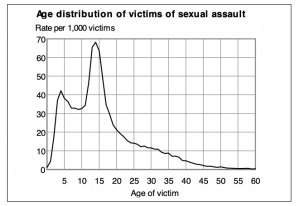1 in 10 children are affected by sexual abuse to possibly as high as 1 in 4 girls and 1 in 6 boys1.
Statistics range from study to study, but estimate that 1 in 10 children are affected by contact-only sexual abuse to possibly as many as 1 in 4 girls and 1 in 6 boys.
Less than 25% of survivors may tell within a year.
Half of victims may wait at least 5 years before telling.
The majority of abuse, even after disclosure, is not reported to the authorities.
It often takes a long time for the child to tell someone, and even though they may disclose to a friend, therapist, or family member – it’s not being reported to the police. The child and family may not want to experience the difficulty of an investigation and possible trial or the adult may not believe the child. Many victims are in adulthood by the time they disclose.
Furthermore, when an abuser is a family member, friend, or minor, the family may decide to not report to the police and deal with the situation on their own. If abuse is reported, cases involving family member are “screened out” by the police to be handled by the Department of Family Services, Child Protective Services, or other non-law enforcement agency that handles domestic issues. CPS must first substantiate abuse before it can be referred to law enforcement for investigation.
Estimates regarding abusers
- 30-40% immediate or extended family members of the victim2
- 50% know their victims and are in a position of trust with the victim and/or family10
- 40% stronger or older children – siblings, cousins, friends, neighbors, community members14
- 7% adults that work in schools3
- Less than 10% are estimated to be strangers
- The majority of people who exploit children through child sexual abuse materials are parents4
- 30% 0f female perpetrators to have a male accomplice while only 2% of all male perpetrators are estimated to have a female accomplice17
Statistics regarding victimization
- Children with physical and intellectual disabilities face increased risk15, 16
- 19% of juvenile sexual assault victimizations, the juvenile was victimized along with another individual5
- 50% of all victims of forcible sodomy, sexual assault with an object, and forcible fondling are under age twelve5
- in 2001, 20% of children will received a sexual solicitation via the internet6
- Less than 1% of child sexual abuse allegations are deemed false13
 While much awareness is raised for sexual assault and rape on college campuses, the reality is, children face sexual abuse at a much higher rate.
While much awareness is raised for sexual assault and rape on college campuses, the reality is, children face sexual abuse at a much higher rate.
Characteristics of Abuse
- Over 80% of children under the age of 12 are abused within a residence – their own, of the perpetrator, or another person5
- For children between the ages of 12-17, 70% of abuse occurred within a residence5
Reporting & Prosecution
Exposing the magnitude of child sexual abuse is challenging because much abuse goes unreported, we must rely on research studies and estimates to gain a sense of how many children are being affected by sexual abuse and exploitation.
- Less than one in five reported cases move forward to prosecution. About half of those cases lead to a conviction or guilty plea11
- The challenges that lead to these low rates of convictions or guilty pleas include:
- the family’s lack of support for the child,
- lack of physical evidence and
- difficulty in attaining victim’s reliable disclosure
There are four types of evidence that predict whether charges will be filed following an investigation of child sexual abuse. These include :
- victim disclosure,
- a corroborating witness,
- confession by the accused perpetrator, and/or
- multiple reports of abuse by the same offender
Barries to Prosecution
One of the most important predictors of a case moving forward is caregiver support. There are cases where a parent defends a perpetrating partner, boyfriend, or girlfriend instead of the child. While there is not one fix for this issue, society can make a better effort to increase the discussion of child sexual abuse and the importance of protecting children by believing them first.
Female perpetrated child sexual abuse cases are not coming to the attention of the judicial system as equally as male-perpetrated child sexual abuse cases are12. Since women are perceived as “less guilty, less violent, and less dangerous”, they are not as likely to be convicted than men are of child sexual abuse. A paper presented to the National Symposium on Child Victimization explained that out of the 83 cases of children reporting they were sexually abused by a woman, only one case had a trial. It is critical that society recognizes the prevalence of female-perpetrated child sexual abuse so that victims can feel more confidence to come forward and report their abuse.
Life after abuse
Children that are sexually abused are at a higher risk to suffer from low self-esteem, depression, anxiety, post-traumatic stress disorder, psychotic and schizophrenic syndromes, conduct/anti-social personality disorder, drug and alcohol abuse, eating disorders, obesity, failure to complete high school, attempted suicide or suicide, increased instability in relationships, more sexual partners, an increased risk of sexual problems and greater negativity towards partners, and prostitution.
Some research suggests that victims of child sexual abuse are at increased risk of re-victimization. Specifically, women who have a history of child sexual abuse are at least twice as likely to experience adult sexual victimization (Classen, Palesh, & Aggarwal, 2005; Maker et al., 2001)
Disclosure differences between male and female victims
Recent research indicates that men are less likely to disclose child sexual abuse during childhood compared with women and to make fewer and more selective disclosures. O’Leary and Barber, for example, reported that 64% of women but only 26% of men had told someone about the abuse when they were children. Men took significantly longer than women to discuss it with someone, and “it was not uncommon … for men to report taking in excess of 20 years to talk about their experiences”.
Cultural images of how “real men” should think, feel and act can create powerful barriers to male victim/survivors of child sexual abuse disclosing their experiences to others, accepting their experience as one that may have had a formative influence on their lives, and healing from the trauma of the abuse. This means that many in society have difficulty fully acknowledging and accepting the reality of the sexual abuse of males during childhood/adolescence, and the trauma it can inflict.
Other researchers have similarly suggested that under-reporting of sexual abuse by boys may be linked to “community assumptions that have often labelled them as future perpetrators: as homosexual; or, because they fear being treated as social outcasts, liars, or as emotionally weak”.
Source: “The long-term effects of child sexual abuse” by Judy Cashmore and Rita Shackel
Sources:
- The Federal Center for Disease Control
- Victimization: Prevalence and Implications, by Kilpatrick, Saunders, and Smith
- Sexual Abuse in schools
- National Institute of Justice. (2007). Commercial sexual exploitation of children
- Sexual Assault of Children as Reported to Law Enforcement
- Youth Internet Safety Survey
- Recall of Childhood Trauma, by Linda Meyer Williams
- Child Sexual Abuse Prevention: What Offenders Tell Us, by Elliott, Browne, and Kilcoyne
- Youth Victimization: Prevalence and Implication
- Child Sexual Abuse Statistics, by Darkness to Light
- The Prosecution of Child Sexual Abuse: A Partnership to Improve Outcomes: Final Summary Overview.
-
Child Sexual Abuse Perpetrated by Women: Case Series and Review of the Literature
- The Leadership Council
- Finkelhor, D. (2012). Characteristics of crimes against juveniles. Durham, NH: Crimes against Children Research Center
- Valenti-Hein & Schwartz, 1995,
- Daigneault I, Paquette G, De La Sablonnière-Griffin M, Dion J. Childhood Sexual Abuse, Intellectual Disability, and Subsequent Physical and Mental Health Disorders: A Matched Cohort Study. Am J Intellect Dev Disabil. 2023 Mar 1;128(2):134-144. doi: 10.1352/1944-7558-128.2.134. PMID: 36807477
- Williams KS, Bierie DM. An incident-based comparison of female and male sexual offenders. Sex Abuse. 2015 Jun;27(3):235-57. doi: 10.1177/1079063214544333. Epub 2014 Jul 29. PMID: 25079779.





